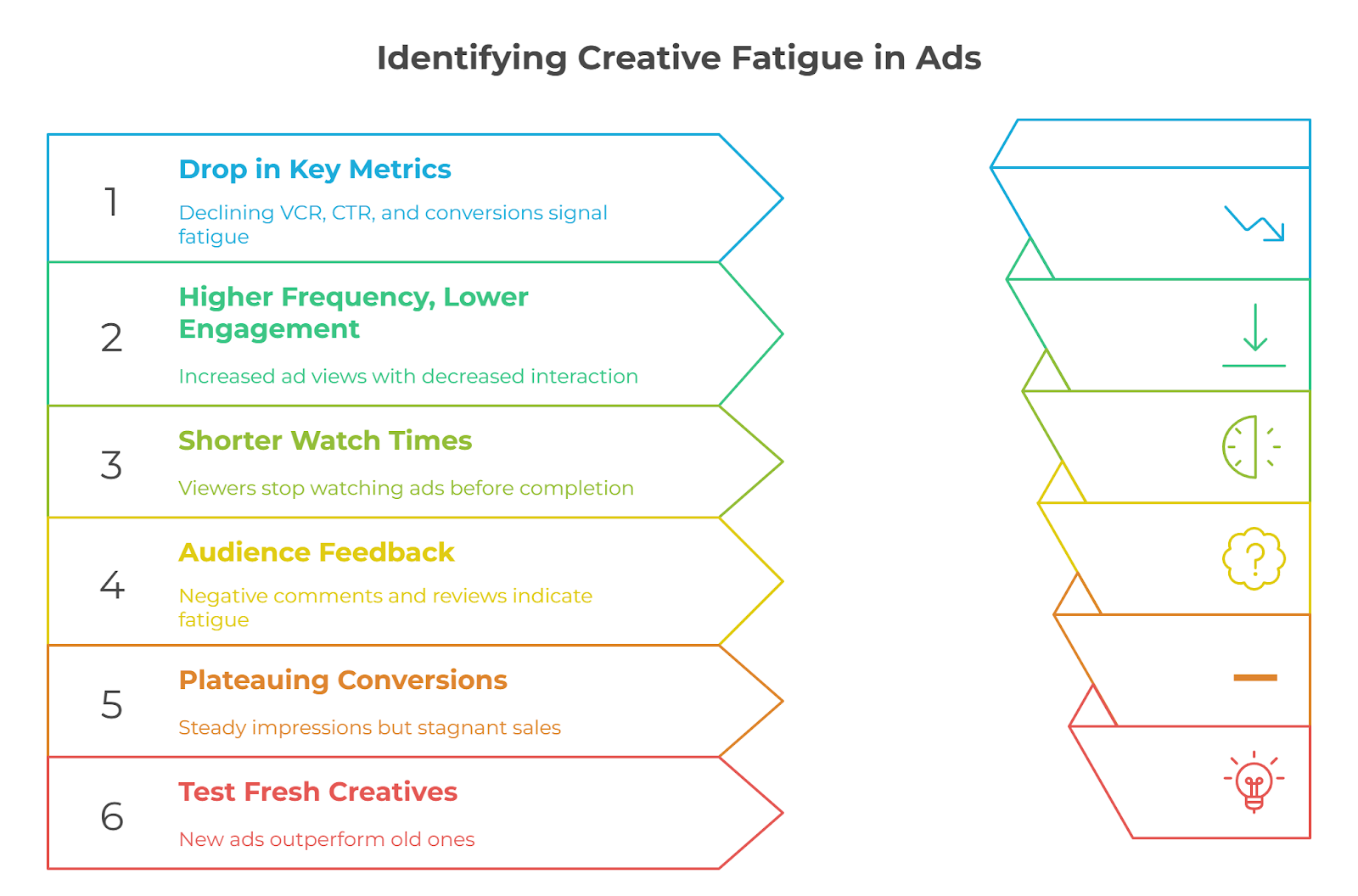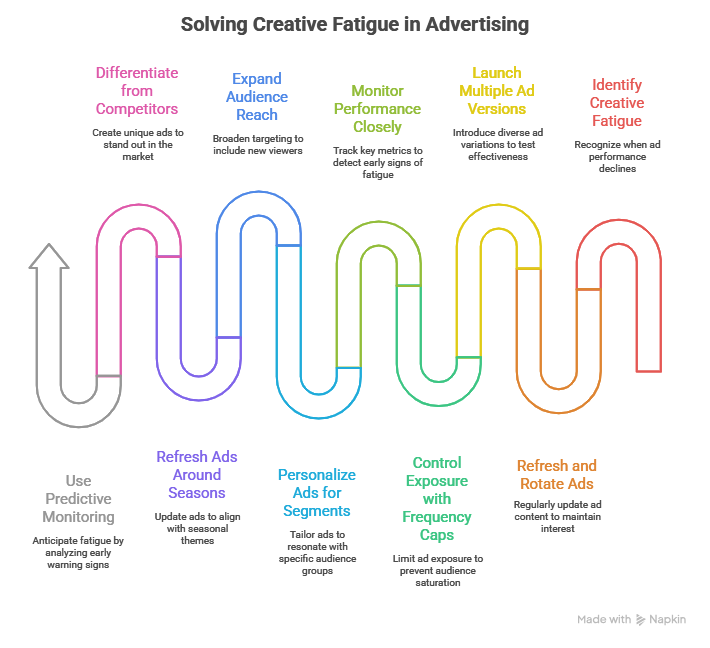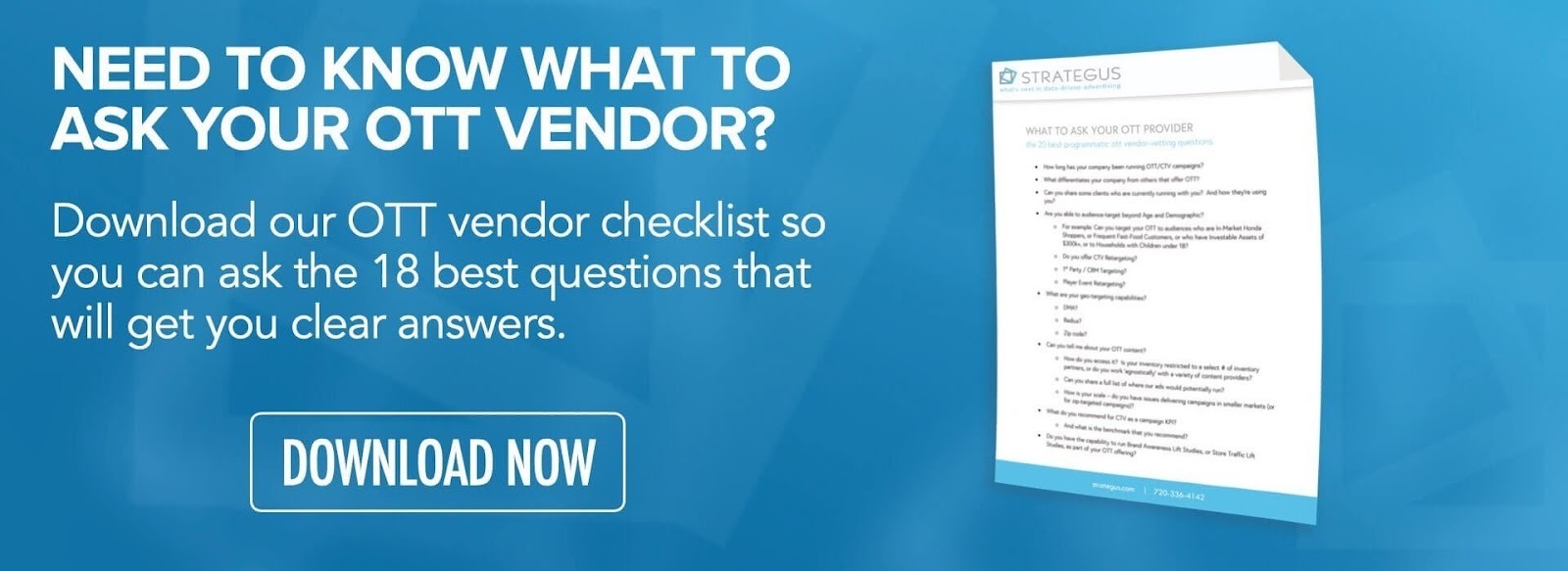- Home
- Strategus Blog
- What is Ad Creative Fatigue & How to Minimize it on OTT/CTV Channels
What is Ad Creative Fatigue & How to Minimize it on OTT/CTV Channels
 Andy Dixon
Andy Dixon
11 minutes read

Your ads may start strong but soon lose their spark. Viewers see the same creative too often, and results begin to drop.
This is ad creative fatigue, a common challenge on OTT and CTV channels where attention is limited. In this article, you’ll learn what it is and how to minimize it for lasting impact.
Key Takeaways
- Creative fatigue occurs when viewers see the same ad too often, leading to a significant drop in engagement. This leads to declining ROI, lower video completion rates, reduced click-through rates, and fewer conversions. On OTT and CTV platforms where viewers stream content daily, this fatigue can set in quickly.
- Early detection is crucial and can be spotted through specific warning signs. Watch for declining metrics like CTR and VCR, increasing frequency with falling engagement, shorter watch times, plateauing conversions despite steady spend, and audience feedback indicating overexposure.
- Prevention requires proactive rotation and variety. Refresh ads every 3-4 weeks, launch with multiple creative versions (3-4 variations), set frequency caps (3-5 exposures per week), personalize for different audience segments, and monitor performance weekly to catch issues early and prevent them from damaging campaign results.
What is Ad Creative Fatigue?
Ad creative fatigue happens when people see the same ad too many times and stop paying attention to it.
When viewers see the same ad too often, it feels boring and repetitive. Engagement drops, clicks go down, and campaign performance weakens. Even strong creatives lose impact once the audience grows tired of them.
Sometimes the audience gets so familiar with a brand’s style that even new ads feel predictable. At other times, trends spread across the industry, and many ads look alike. This lack of originality makes people feel they’ve already seen the ad, so they stop paying attention.
On OTT and CTV channels, where viewers stream content daily, creative fatigue shows up fast. If ads do not change often, audiences tune them out. To avoid this, advertisers must refresh creatives regularly and balance reach with frequency.
How Ad Creative Fatigue Hurts Campaign Performance
Ad creative fatigue is more than just a dip in engagement. It creates a ripple effect that directly impacts your return on investment and the overall success of your campaigns. Once audiences lose interest, every part of the funnel feels the impact.
Here’s how it plays out:
1. Decline in ROI
When ads stop capturing attention, fewer people engage, click, or convert. That means the same ad spend delivers less value over time. For example, a CTV campaign that once brought in strong conversions can quickly turn into wasted impressions if the creative feels stale.
2. Lower Video Completion Rate (VCR)
If viewers get bored, they stop watching before the ad finishes. A lower VCR means your message never fully lands. On OTT platforms where completion is key for brand recall, this loss of attention weakens both awareness and brand lift.
3. Drop in Click-Through Rate (CTR)
When ads feel repetitive, fewer viewers interact with them. CTR falls because the audience no longer feels motivated to take action. This is especially damaging if the campaign goal is traffic or engagement, where clicks are the main driver of success.
4. Fewer Conversions and Attributions
Creative fatigue leads to fewer sign-ups, purchases, or store visits. Even offline attribution suffers because people no longer connect with the ad strongly enough to take the next step. For instance, a retail brand might notice foot traffic decline even though ad frequency hasn’t changed, simply because the creative feels worn out.
5. Brand Perception Damage
When audiences repeatedly see tired or predictable ads, they may start associating the brand with being unoriginal. Over time, this weakens brand perception and trust. Instead of being seen as innovative, the brand risks blending into the noise.
6. Industry-Wide Similarity
Creative fatigue isn’t always tied to a single ad. Many marketers borrow “proven” tactics, leading to ads across different brands looking and sounding alike. For example, the same upbeat background music or predictable “before-and-after” format shows up everywhere. Viewers then lump your ad with dozens of others, reducing its impact.
7. Missed Growth Opportunities
If you keep running fatigued creatives, you’re not testing new ideas that could potentially get you better performance. This creates opportunity cost. A fresh creative might not only maintain engagement but also reveal new insights about your audience’s preferences.
What are Some Signs of Creative Fatigue & How to Spot Them Early
Ad creative fatigue rarely happens overnight. It builds up as people see the same ad too often and slowly stop responding. If you track the right signals, you can catch it early and make changes before your campaign suffers.
Here are the main signs to watch:

1. Drop in Key Metrics
Keep an eye on video completion rate (VCR), click-through rate (CTR), and conversions. If they fall week over week, your ad may no longer hold attention. For example, a CTR that drops from 1.5% to 0.7% within two weeks is a strong warning sign.
2. Higher Frequency with Lower Engagement
Check how often the same viewer sees your ad. If frequency rises but engagement falls, people have grown tired of it. For instance, an average frequency of 6 with falling clicks shows that your message is being ignored.
3. Shorter Watch Times
Look at how long viewers stay with your ad. If people stop watching halfway through instead of finishing, fatigue has likely set in. This is common with 30-second OTT ads where average watch time drops to 10-12 seconds.
4. Audience Feedback
Listen to what people say about your ads. Comments like “I keep seeing this” or “boring” are direct signals. Check reviews, social mentions, and feedback forms to spot early signs that your audience feels overloaded.
5. Plateauing Conversions
If impressions and spend stay steady but conversions stop growing, the creative is likely the problem. For example, an e-commerce brand may keep showing the same discount ad, but sales stall because viewers no longer feel motivated to act.
6. Test Against Fresh Creatives
Run A/B tests with a new creative. If the new version beats the old one quickly, your audience has already lost interest in the first ad. This test gives you proof and helps you decide when to rotate creatives.
7. Compare to Benchmarks
Track your results against industry averages for OTT and CTV. If your numbers fall behind what is typical for your category, creative fatigue may be dragging performance down. For example, if the average VCR in your category is 90% and yours slips to 70%, it is time to refresh.
8. Look for Engagement Gaps Across Segments
Break down your data by audience groups. If certain segments stop engaging faster than others, it shows where fatigue is setting in first. For example, younger viewers may tune out quicker than older ones.
How to Measure Creative Fatigue
Before you can fix creative fatigue, you need to measure it accurately. OTT and CTV campaigns generate rich performance data, and by tracking the right metrics, you can spot when your ads begin to lose their impact.
Here are the key ways to measure creative fatigue:
- Track Engagement Metrics Over Time: Look at how click-through rate (CTR), video completion rate (VCR), and conversions trend week by week. A sharp drop in these numbers is often the first sign of fatigue. For example, if CTR falls from 1.2% to 0.5% over two weeks, your audience is losing interest.
- Monitor Frequency and Reach Together: Fatigue often shows up when the same users see your ad too many times. Measure average frequency alongside engagement. If frequency climbs but engagement declines, it means your creative has worn out. Aim to balance frequency caps with expanded reach.
- Compare New vs. Old Creatives: Run A/B tests with fresh variations. If a new creative outperforms the old one quickly, the older ad has likely hit fatigue. This comparison is one of the most reliable ways to confirm fatigue instead of guessing based on trends.
- Study Landing Page Interactions: Use your landing page as a performance checkpoint. If conversions dip, bounce rates climb, or users stop scrolling, it may signal that your creative no longer resonates. Proper attribution tracking helps you connect these drops directly back to ad performance.
- Break Down Results by Audience Segment: Analyze performance by age, location, or device type. Some segments may hit fatigue sooner than others. For instance, retargeted users might stop engaging faster than new audiences. Measuring at the segment level shows you where to refresh first.
- Benchmark Against Industry Standards: Compare your performance against industry averages for OTT and CTV. If your VCR, CTR, or conversions fall well below category norms, it may be because of fatigue rather than audience mismatch.
How to Solve Creative Fatigue
Creative fatigue shows up when performance drops and your ads no longer capture attention. Solving it means taking both quick corrective steps and long-term measures that keep ads fresh.
On OTT and CTV, where viewers stream content daily, you need a plan that fixes fatigue fast and prevents it from happening again.

Here’s how you can deal with ad creative fatigue:
1. Refresh and Rotate Ads Regularly
Do not run the same ad for too long. Set a schedule to rotate creatives every 3–4 weeks, even if performance looks steady. Change the visuals, story arc, or call-to-action so the ad feels new. For example, a retail brand can alternate between a product-focused ad and a lifestyle-focused version to keep interest alive.
2. Launch With Multiple Versions at Once
Start campaigns with at least 3-4 ad variations. Mix short and long versions (15s vs 30s), different visuals, and alternative CTAs. This not only slows fatigue but also helps identify which style works best. Platforms like Strategus can manage these variations across OTT and CTV and optimize delivery automatically.
3. Control Exposure With Frequency Caps
One of the fastest ways to solve fatigue is to manage how often the same person sees your ad. A good rule is 3-5 exposures per week. If you push beyond that, engagement often falls. Frequency caps protect your audience and give you room to introduce fresh creatives over time.
4. Monitor Performance Closely and Act Fast
Do not wait for conversions to crash. Track VCR, CTR, and conversion trends weekly. If you see numbers dip, introduce a new creative right away. A/B test fresh ads against current ones to confirm fatigue. Tools like the Strategus reporting dashboard make this process easier by giving you real-time insights.
5. Personalize Ads for Different Audience Segments
Fatigue often comes from showing the same message to everyone. Instead, adapt creatives to each audience group. For example, a food delivery app can highlight convenience for busy professionals and low fees for students. Personalization makes ads feel relevant, which extends their shelf life.
6. Expand Audience Reach
If you keep hitting the same narrow segment, fatigue builds faster. Broaden your reach to include new audiences while keeping targeting precise. With OTT/CTV, you can combine first-party data, contextual targeting, and retargeting so the same viewers are not overloaded.
7. Refresh Ads Around Seasons and Events
Audiences notice when ads match the season or current events. Adjust campaigns for cultural moments, sales periods, or trends. A travel brand, for example, can push summer getaways in June, holiday breaks in December, and weekend trips in spring. This solves fatigue by making your ads feel timely.
8. Differentiate From Competitors
Creative fatigue can happen when your ads look like everyone else’s. Review competitor campaigns and shift your approach to stand out. If most brands in your space use upbeat lifestyle shots, consider using humor, animation, or storytelling to grab attention again.
9. Use Predictive Monitoring
Look for early warning signs like rising frequency and flat engagement. These patterns show fatigue before conversions drop. By solving the issue early, you avoid wasted impressions and keep ROI strong. Use predictive data from campaign dashboards to time your creative refreshes more accurately.
Closing Thoughts — Solving Creative Fatigue with Strategus
Creative fatigue can stall even the strongest OTT and CTV campaigns. When audiences see the same ad too often, engagement drops and performance declines, but with the right partner, you can keep your campaigns fresh, relevant, and effective.
At Strategus, we don’t just manage campaigns. We’ve built a culture that optimizes them continuously. Our team monitors performance in real time, rotating creative assets proactively to maintain engagement and prevent overexposure. Smart frequency caps ensure your message reaches the right people without overwhelming them, while advanced targeting helps balance broad visibility with precision delivery.
We back every decision with transparent reporting and actionable insights, so you always know how your budget is driving results. And because we manage every step hands-on, you can focus on growth while we handle the complexity.
Don’t let creative fatigue drain your ad spend or stall your momentum. Talk to a Strategus expert today to learn more about how we can help.
Frequently Asked Questions
How Long Does It Usually Take for Ad Creative Fatigue to Set In?
Creative fatigue can appear within a few weeks if ads run at high frequency or target a small audience. On OTT and CTV channels, where viewing time is high, fatigue often sets in faster than on other platforms. Monitoring trends weekly helps you catch it early.
Does Creative Fatigue Affect Brand Awareness Campaigns the Same Way as Performance Campaigns?
Yes, both types of campaigns can suffer from fatigue. Awareness ads lose their novelty, leading to lower recall over time. Performance ads experience weaker clicks and conversions. In both cases, the brand impact declines unless creatives are refreshed or rotated strategically.
How Do Small Businesses Handle Creative Fatigue With Limited Budgets?
Small businesses can fight fatigue by planning variations in advance. Instead of producing entirely new ads, they can update visuals, change offers, or tweak calls-to-action. Using tools that manage frequency caps and audience targeting can stretch ad life without overspending.
Is Creative Fatigue Worse on Ctv Than on Social Media?
CTV and social media both face creative fatigue, but in different ways. On social, people scroll quickly, so fatigue shows in lower engagement. On CTV, audiences watch longer content, so seeing the same ad several times in one sitting makes fatigue more noticeable.
Can Strong Targeting Alone Prevent Creative Fatigue?
Strong targeting reduces wasted impressions but does not fully prevent fatigue. Even the right audience grows tired of seeing the same ad. The best approach combines smart targeting with regular creative refreshes and frequency controls to keep viewers interested and engaged.
How Does Creative Fatigue Impact Long-Term Brand Trust?
If viewers feel bombarded with repetitive ads, they may associate the brand with being pushy or unoriginal. Over time, this weakens trust and credibility. Brands that regularly refresh ads and keep messaging relevant are seen as more innovative and reliable.
What Role Does Storytelling Play in Reducing Creative Fatigue?
Storytelling helps extend the life of a campaign by presenting variety and progression. Instead of repeating one message, brands can create a series of ads that continue a story. This makes each ad feel fresh while reinforcing the same core brand message.
How Can Advertisers Tell if Landing Page Fatigue Is the Problem Instead of Creative Fatigue?
If ads drive clicks but landing page conversions fall, the issue may lie with the page. High bounce rates or short time on site suggest landing page fatigue. Testing new page layouts, headlines, or offers helps confirm whether the creative or the page is underperforming.
What Tools Are Most Effective for Monitoring Creative Fatigue?
Performance dashboards, attribution platforms, and A/B testing tools are the most effective. Platforms like Strategus provide real-time insights on VCR, CTR, and conversions, making it easier to see when ads are losing impact and need to be rotated.
When Should Advertisers Bring In a Managed-Service Partner to Handle Creative Fatigue?
If campaigns run at scale, span multiple channels, or require constant testing, working with a partner is often the best move. A managed-service provider like Strategus handles creative rotation, targeting, and performance monitoring, freeing up advertisers to focus on strategy instead of daily campaign adjustments.

Andy Dixon is a seasoned Content Writing Specialist at Strategus, renowned for his expertise in creating engaging and impactful digital content. With over a decade of experience in content creation, Andy has honed his skills in a variety of niches, ranging from technology and marketing to education.
Strategus is a managed services connected TV(CTV) advertising agency with over 60,000+ campaigns delivered. Find out how our experts can extend your team and drive the result that matter most.
Talk to an Expert
Seeking a Custom CTV Strategy That Delivers?
What to read next
App Event Tracking: Tie Mobile App Activity to CTV Campaigns
Let’s say you’re running a CTV campaign for a personal finance app.
5 minutes read

Stop Guessing Who Your Audience Is — Let Their Apps Tell You
Connected TV (CTV) targeting often falls in one of two camps.
8 minutes read
See Who Bought After Your Ad + How Much They Spent
You can’t improve what you can’t measure. And for years, that’s been a major problem with TV advertising.
4 minutes read

First-Party Attribution: Match Ads to Sales With CRM Data
The value of first-party data continues to grow.
7 minutes read















